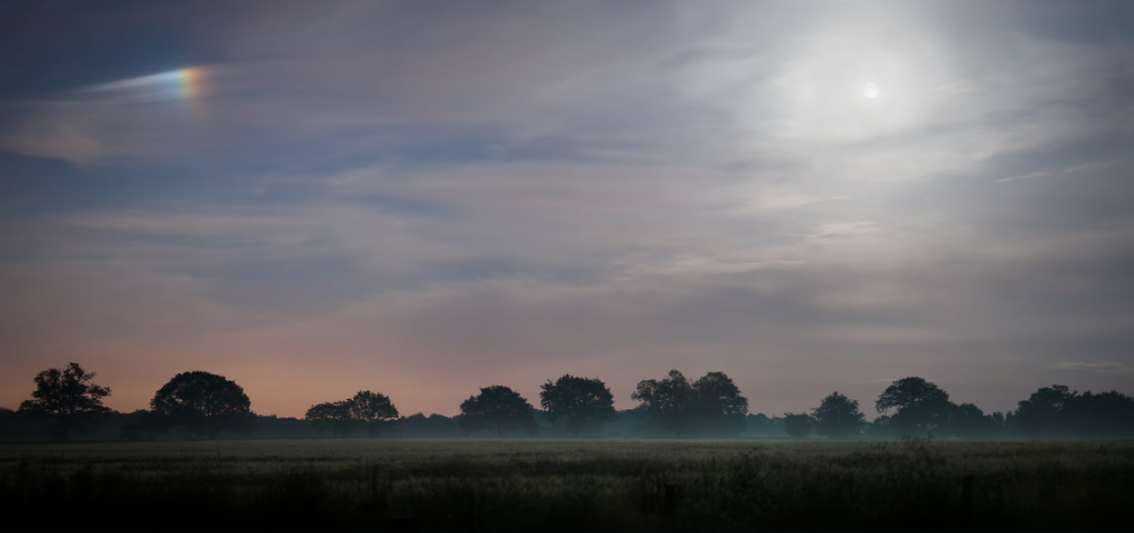OPOD - Shropshire paraselene
OPOD - Shropshire Paraselene: A Stunning Display of Atmospheric Optics
When it comes to atmospheric optics, few phenomena capture the imagination quite like the paraselene. Recently, the skies over Shropshire, England were graced with a breathtaking display of this colorful moondog. Photographer Andrew Steele captured the moment, revealing the paraselene's vibrant hues against the backdrop of a cloudy moon and a foreground of radiation fog-laden barley fields. Let's delve deeper into the fascinating world of paraselenae and uncover the science behind their formation.
Unveiling the Science behind Paraselenae
Paraselenae, much like sundogs, are formed by hexagonal plate ice crystals found in high-altitude clouds. The process begins when light rays enter a crystal's side face. Due to the nature of refraction, blue light is refracted more strongly than red light, resulting in a separation of colors. As the rays exit through another side face angled at approximately 60 degrees to the first, the dispersion of colors becomes even more pronounced.
The journey of light through these crystals is not always straightforward. When the sun is close to the horizon, the path is relatively simple. However, for light from a higher sun to pass through the thin ice plates, it must reflect up and down between the larger upper and lower crystal facets. This intricate interplay of reflection and refraction gives rise to the mesmerizing spectacle of a paraselene.
The Magic of Color Separation
One of the most captivating aspects of paraselenae is the vivid color separation that occurs within them. As sunlight enters the ice crystals, it splits into its constituent colors, resulting in a stunning display of reds, blues, and other hues. The degree of color separation depends on various factors such as crystal size, shape, and orientation.
Exploring the Coronal Halo
While the paraselene steals the show, keen observers may also notice the presence of a corona encircling the moon. Unlike the paraselene, which is caused by refraction, the corona is formed through diffraction. This optical phenomenon occurs when light waves encounter small water droplets or ice crystals in the atmosphere, causing them to diffract or bend.
Atmospheric Conditions and Visualizing Paraselenae
To witness the beauty of a paraselene, specific atmospheric conditions must align. The presence of high-altitude clouds composed of hexagonal plate ice crystals is essential. These clouds often form at altitudes where temperatures are below freezing, allowing for the formation of ice crystals.
Additionally, the angle between the observer, the sun, and the ice crystals must be just right to create the optimal conditions for a paraselene to manifest. This alignment ensures that sunlight is refracted and reflected through the crystals, resulting in the vivid display we see.
The Splendor of Atmospheric Optics
The occurrence of a paraselene is a testament to the intricate dance between light and ice crystals in our atmosphere. These fleeting moments of beauty remind us of the awe-inspiring wonders that surround us daily. From vibrant colors to ethereal halos, atmospheric optics continues to captivate both scientists and enthusiasts alike.
Conclusion
The Shropshire paraselene captured by Andrew Steele serves as a vivid reminder of the breathtaking displays that can unfold in our skies. Through a delicate interplay of reflection and refraction within hexagonal plate ice crystals, paraselenae reveal a stunning array of colors. Whether it's observing the colorful moondogs or marveling at the corona encircling the moon, atmospheric optics offers a glimpse into the hidden beauty of our atmosphere. So, keep your eyes to the sky, and you may just catch a glimpse of these mesmerizing displays yourself.

Pastoral Paraselene ~ A colourful moondog, a paraselene, lights the Shropshire, England sky. Around the cloudy moon a corona hints its presence, its diffraction no rival to the hearty refraction of the moondog. Radiation fog layers a foreground barley field. An image by Andrew Steele ( andrewsteele.co.uk ). ©Andrew Steele, shown with permission.

Paraselenae like sundogs are formed by hexagonal plate ice crystals in high cloud.
Colour separation occurs as rays enter a crystal side face. Blue refracts more strongly than red. Colours disperse further when rays leave through another side face angled 60° to the first.
The route through the crystal is only straightforward when the sun is close to the horizon. To get light of a higher sun through the thin ice plate the rays must reflect up and down between the large upper and lower crystal facets.
Note: this article has been automatically converted from the old site and may not appear as intended. You can find the original article here.
Reference Atmospheric Optics
If you use any of the definitions, information, or data presented on Atmospheric Optics, please copy the link or reference below to properly credit us as the reference source. Thank you!
-
<a href="https://atoptics.co.uk/blog/opod-shropshire-paraselene/">OPOD - Shropshire paraselene</a>
-
"OPOD - Shropshire paraselene". Atmospheric Optics. Accessed on November 26, 2024. https://atoptics.co.uk/blog/opod-shropshire-paraselene/.
-
"OPOD - Shropshire paraselene". Atmospheric Optics, https://atoptics.co.uk/blog/opod-shropshire-paraselene/. Accessed 26 November, 2024
-
OPOD - Shropshire paraselene. Atmospheric Optics. Retrieved from https://atoptics.co.uk/blog/opod-shropshire-paraselene/.